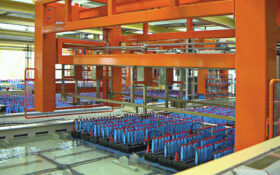In December 2020, the Consortium for Battery Innovation and four industry partners launched a project probing how to enhance the performance of lead batteries by mixing common additives in different ratios. BEST looks at how the project is progressing.
In December, the global pre-competitive research organisation Consortium for Battery Innovation (CBI) launched an 18-month project titled: Investigation into the Combined Influence of Carbon Black and Organic Expander to Improve Micro-Hybrid Service of Enhanced Flooded Batteries. The project’s goal was to improve the overall performance of lead batteries and reduce carbon emissions in start-stop, micro and mild-hybrid vehicles.
In 2019, CBI’s technical roadmap identified that improving dynamic charge acceptance (DCA) of lead batteries in micro and mild-hybrid cars from 0.5A/Ah to 2A/Ah was one of the highest-priority research and innovation goals in the automotive arena. The roadmap also set out goals to double partial-state-of-charge (PSoC) at 17.5% depth of discharge in enhanced flooded batteries to 3,000 in the next three years. In the energy storage sector, the roadmap wanted to improve the cycle life for batteries in stationary applications to 6,000— up from 1-3,000 in 2018— and charge acceptance to around 95% by 2025.
The key performance indicators (KPIs) are key considerations as global bans on the sale of internal combustion engine (ICE) vehicles are slowly introduced, with Europe starting from 2025, and California leading the way in the US a decade later (although states including Hawaii and Washington are considering bans beginning in 2030, but have not ratified any policies to date). A key goal of the endeavour is to optimise and establish a functional relationship between the expander and conductive additives to enhance lead battery performance for DCA, high-temperature durability and energy throughput.
The team is comprised of: CBI, battery manufacturer and recycler East Penn Manufacturing and materials suppliers Hammond Group, Cabot and Borregaard Lignotech. Each member has a clearly defined role that leverages their respective expertise and experience, which includes: carbons from Cabot, lignin from Borregaard and Hammond’s infrastructure to offer them as unique blends.
In fact, Hammond— a well-known supplier of a premium pre-blended expander for the lead-acid battery industry— has two roles in this project. The first is to pre-blend the expander components for each variable in the battery build. This is important, especially on a small scale, to make sure that there is a homogeneity of all the components within the final paste mix. All the pre-blended expanders (including the materials for this CBI project) are inspected and approved by Hammond’s IATF-certified QA system.
Hammond’s second role in the project is to perform the DCA test on each of the variables in the build. “Our laboratory is equipped with battery test circuits that can accommodate high-rate testing,” says Maureen Sherrick, senior product engineer at Hammond. Test results will be discussed among the team to enable plans for the next steps to be made.
Meeting KPIs
The team aims to improve the following parameters through the optimisation of additive ratios:
- Increase the dynamic charge acceptance to higher than 0.40A/Ah using DCA run-in testing
- High-temperature durability— providing up to 19 units on J2801 testing and other test sequences
- Energy throughput of lead batteries, by demonstrating a much higher cycle life in DoD 17.5% testing when compared to a typical lead battery control
Initial findings, published in February, have shown that optimisation of additive ratios improves DCA by 40%, with the initial analysis of the amount of each additive mix component showing correlations to formation behaviour; although more detailed figures have not been released. We do know, however, there has been a representative sample of a 12V lead battery produced to test and study these relationships at the product level. The result of the project will not be a single battery material but rather a formulation for negative active material that allows for high DCA along with meeting other battery tests/criteria, says Paolina Atanassova, senior business development manager at Cabot Corporation.
Technical project IP could potentially be patented as a group, with all CBI members having a royalty-free license to the patent; a standard procedure for most CBI projects like this. Matt Raiford, technical manager at CBI, says the project is completely transparent from a preparation and analysis perspective, with the group cataloguing and detailing the preparation of the electrodes, batteries, and additive blends to a “high amount of detail”.
The high amount of detail on structure and methods will make the additive mixes and resulting test batteries replicable in any CBI member research facility. A high level of detail will also allow for quick translation of any material discoveries into the organisation’s members’ own products and studies.
“All the tests performed will reveal the effect of variation of organic and carbon loading levels,” says Sherrick. “The output of this project should help battery manufacturers and researchers to determine combinations of materials that will lead to the highest KPI results.”
The output of this project should help battery manufacturers and researchers to determine combinations of materials that will lead to the highest KPI results.
Why Carbon
The use of carbon to improve performance in lead batteries has been well-known for nearly a decade and, as such, is a proven additive material. Adding carbon into an electrode, or as the main composition material for the negative electrode, provides a reliable and simple pathway for performance improvements in lead batteries for cycle life, lifetime and DCA. Expander and conductive additives improve the performance of lead-battery negative electrodes, however, the way they interact and work with each other is less well-defined.
The project will systematically study different ratios of the common additives used in the industry (carbon, lignosulfonate and barium sulphate), with the overall objective of optimising DCA and performance at PSoC.
To date, the project has addressed the interaction of one carbon with one lignosulfonate while keeping the barium sulfate versus oxide constant. “The trend that we have seen with the combinations will hold true for many other material combinations, however, it will still be necessary to run a small number of tests to optimise performance results,” says Sherrick. “I believe that to meet the target KPIs established by CBI, many, if not all components must be optimised. The focus of our project, organic and carbon black interaction is one piece of the puzzle.”
New insights
A benefit of research programmes such as these is providing significant new insights into making the next generation of advanced lead batteries. To date, the project has demonstrated the necessity to tailor the additives (and respective ratio of materials within) in the negative electrode to the desired performance. “For instance, some ratios are optimal for cold crank performance (CCA) and others maximise dynamic charge acceptance, and of course, ratios that toe the line and provide a moderate benefit to both categories,” says Raiford.
Understanding how additives are formulated is important in providing further improvement in DCA without compromising baseline metrics like CCA (cold cranking amps). Furthermore, the project has shown further synergies (and possible negative interference) between different additives for other key performance indicators, such as high-temperature durability and PSoC operation, says Raiford.
He adds that understanding the best combination of additive types (barium sulfate, carbon, and lignin) and how they are added to negative electrodes for specific purposes could one day be easily implemented into the manufacturing process by CBI’s members.
“I believe the project shows, definitively, that the use of statistical process methods like the design of experiment, and data analysis tools, are critical for the design of advanced lead-acid batteries,” says Sherrick. “Use of a small number of well-chosen variables results in trends that can be used to predict performance and optimise additives as needed for specific applications.”
Wider implications
The project was devised to improve the performance of automotive applications— specifically for micro and mild-hybrid vehicles. However, there are opportunities for the research to have wider implications beyond the automotive sector. In motive power and ESS applications, PSoC operation and faster recharge capabilities are important, and lead batteries have made strides in these arenas in the last ten years.
Although most attention for higher charge acceptance and low gassing attributes is focused on automotive applications, I believe the industry in all sectors has similar needs, says Sherrick. She includes industrial forklifts, renewable energy and even golf car applications in her list because they are facing industry changes that require high charge acceptance for faster recharge, which in turn causes higher operating temperatures, that then push toward higher water loss.
However, Raiford says there is still some way to go to meet the highly ambitious techno-economic goals stakeholders in the ESS application space have. “Lead batteries (and other chemistries) must increase total energy throughput dramatically to meet these cost metrics,” says Raiford.
Lead batteries (and other chemistries) must increase total energy throughput dramatically to meet these cost metrics
Innovation in additives is not the sole arena for improvement, but optimising additive ratios is a “quick” way to bring increased performance into motive power and ESS applications, he says. “In the next five years, I think the lead battery performance floor will rise for products in these applications.”
As an example, the range of capacity turnover in the ESS space starts with lead batteries performing around 1,000 capacity turnovers to more robust, higher-performing products with more than 4,000 capacity turnovers (equitable with lithium products). Capacity turnover indicates the amount of possible energy throughput in relation to the capacity of the battery. A higher capacity turnover indicates the battery provides more energy over its lifetime. Levelised cost of energy is a key reason given by energy storage system developers for choosing lithium-ion.
The importance of optimised additive packages is pertinent here because increasing the capacity turnover range to 1,500-5,000 with little impact on cost could be a game changer for the lead battery industry. “The KPIs highlighted in this project apply to all other applications and the output of this project gives manufacturers and researchers a clear starting point for development,” says Sherick.
“Hammond Group additionally has the experience and expertise to mix, bag and deliver homogenous formulations using a wide variety of components in various combinations.”












